
Mosquito Infestation: Watch Out for These Common Watering Mistakes!
Actions to avoid to prevent a mosquito invasion this summer
Contents
Every year, mosquitoes are the unwelcome guests in our gardens and homes. Impact on our quality of life, health issues, effect on biodiversity… Their excessive presence causes numerous problems. Unfortunately, without realising it, we may ourselves encourage their appearance and proliferation. Since these insects need stagnant water to reproduce, it’s particularly in plant watering that we need to be cautious. Discover the common mistakes that benefit mosquitoes and how best to limit their presence.
The importance of stagnant water for mosquitoes
We mainly encounter two mosquitoes in our territory: the common mosquito (Culex pipiens) and the tiger mosquito (Aedes albopictus), its cousin from Asia now present in almost all regions of France. Whether in urban or rural areas, mosquitoes find ideal conditions for their development: food, warmth and moisture.
The life cycle of these insects is rapid and efficient. Each female can lay several hundred eggs in various breeding sites that collect minimal water (called “larval habitats”). These eggs can withstand drought or cold for weeks, then hatch when moisture and warmth return. Just a tiny amount of standing water is enough for them to hatch.
It’s worth noting that mosquitoes don’t stray far from their birthplace. On average, each mosquito stays within a radius of 150 metres.
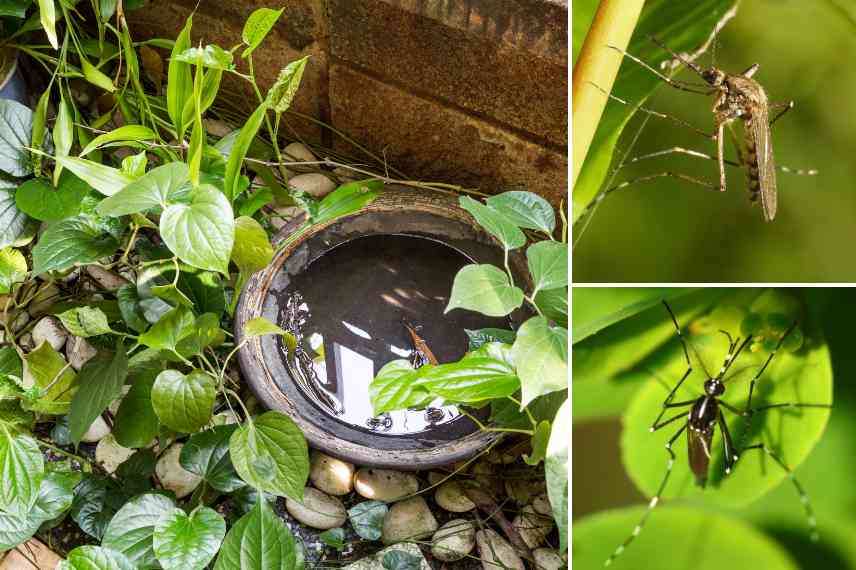
Common and tiger mosquitoes proliferate as soon as they find even a few centimetres of standing water…
The water left in the saucers
Many of us use saucers or plant pot covers for our plants. But these areas can easily retain stagnant water, which attracts mosquitoes and encourages their proliferation. To reduce the risks, we recommend emptying saucers and plant pot covers about twenty minutes after watering. Ideally, this action should also be applied after rainfall.
Moreover, getting into the habit of emptying saucers is often beneficial for plants: many do not appreciate stagnant water, which can lead to root rot.
For plants that require permanently moist soil, you can add sand and clay pebbles to the bottom of saucers. This helps keep the substrate fresh without stagnant water.
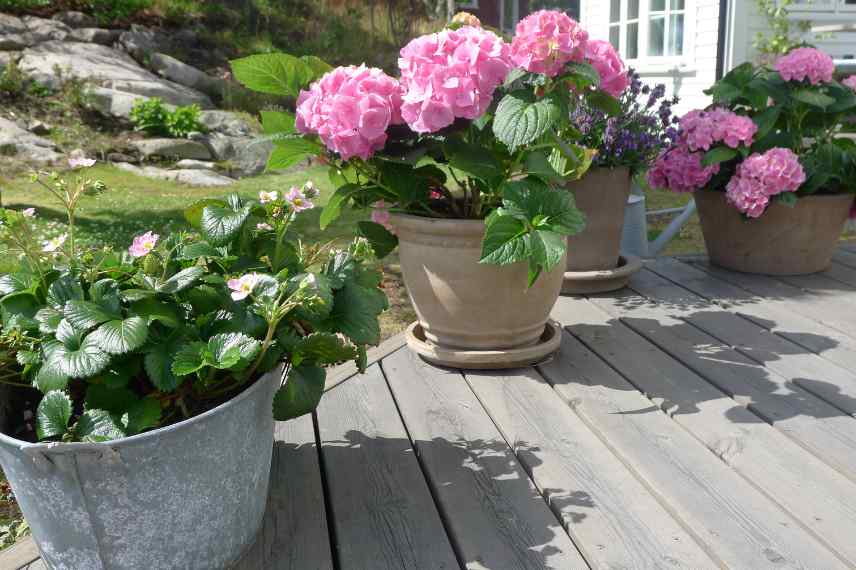
Saucers left filled with water are often the primary cause of mosquito appearance and multiplication
The poorly managed rainwater collector
Having a rainwater collector offers many advantages in the garden.
- It’s an ecological and 100% natural solution that allows you to make the most of rainwater instead of using groundwater reserves. Water is indeed becoming a scarce resource: it is therefore important to preserve it. Having a rainwater collector is particularly useful during droughts and watering restrictions.
- It’s an economical solution: rainwater is free.
- Rainwater contains fewer chemicals (such as chlorine) than tap water. It is also less calcareous, which is especially beneficial for acidophilous plants.
- A rainwater tank helps reduce the effects of runoff during heavy rainfall, which can lead to flooding.
However, despite their many benefits, rainwater collectors have one major drawback: they provide stagnant water that attracts mosquitoes. Unlike a well-balanced pond or water feature, there are no natural predators for mosquito eggs, larvae, or adults in the tank. There are also no pumps or fountains to create water movement and prevent stagnation.
Fortunately, a few simple measures can help limit mosquito proliferation.
- Choose a closed rainwater collector with a tightly fitted lid. Avoid open barrels or tanks at all costs. To improve sealing, you can add a silicone seal, especially around the edges of the downpipe that feeds the tank.
- Add a mosquito net. Install it above or below the lid to prevent mosquitoes from entering the tank. Ensure it is securely fastened with a tight string and choose a fine-mesh model. For the downpipe, make sure the net extends at least 2 cm upwards to stop mosquitoes from slipping through.
- Maintain the tank. Regular maintenance will further disrupt mosquitoes. Remove any plant debris as it accumulates. Once a year, in autumn, empty and clean the tank thoroughly.
- Opt for an underground tank. This is an effective way to make the rainwater collector inaccessible to mosquitoes. However, this is a much more expensive solution that requires space and deep excavation.
- Try anti-mosquito products. There are larvicidal tablets designed for stagnant water and fish-free ponds. These contain a bacterium called Bacillus thuringiensis israelensis (BTI), which kills larvae before they can mature, breaking the mosquito breeding cycle. They are marketed as safe for humans, other animals, and aquatic organisms. However, they can be costly for treating a tank throughout the season. You could also try wood charcoal, which is reputed to prevent mosquito development while purifying the water. On the other hand, we advise against chemical insecticides—they are non-selective, polluting, and have a significant environmental and health impact.
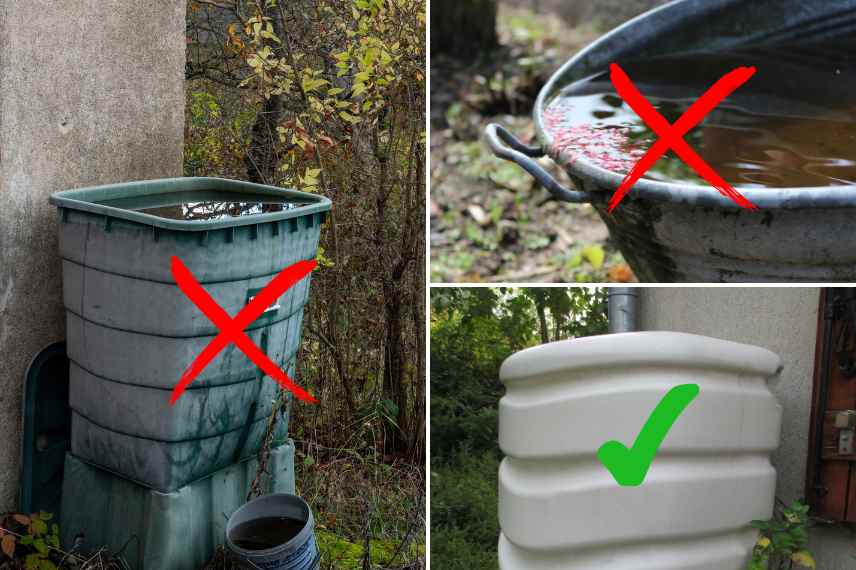
Rainwater collectors must never be left open
Overwatering
To save time, we might be tempted to favour heavy watering less frequently. However, this practice can encourage mosquito breeding by creating puddles and saturating the soil with water. Ideally, opt for moderate watering, even if it needs to be more regular. This also encourages plants to develop their root system more deeply and less superficially, enabling them to draw water from the soil. Avoid using a hose or watering can with a large spout. Instead, choose fine spray watering with a watering can rose.
You could also consider drip irrigation systems or porous soaker hoses, which are gentler and more gradual. However, ensure the flow rate is appropriate and doesn’t lead to water pooling.
To space out watering, remember never to leave bare soil: apply an organic mulch around your plants. This helps retain moisture by reducing natural evaporation.
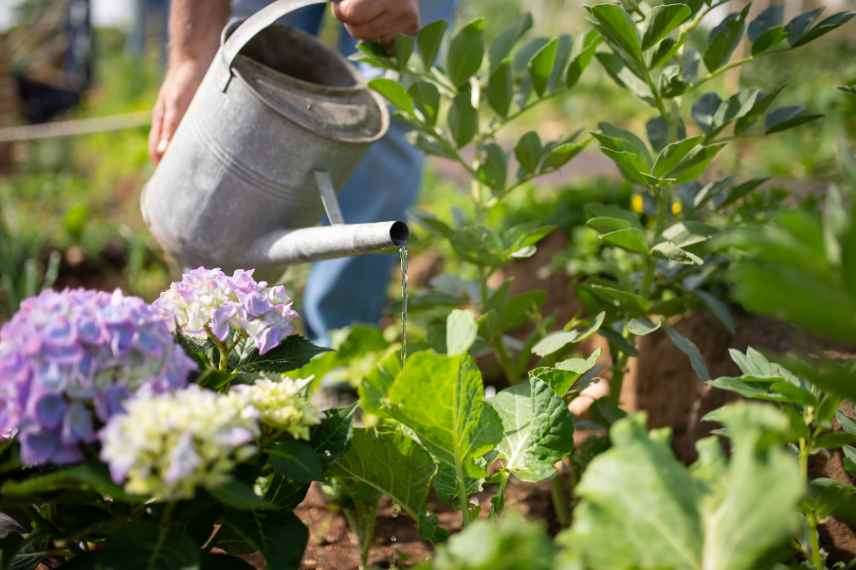
Measure your water application in the garden, as well as in pots
Small abandoned garden tools
When gardening, it’s common to forget a tool, a bucket, a bucket, a wheelbarrow or a watering can here and there. However, this is one of the bad practices that encourage mosquito proliferation. Remember to turn containers upside down to avoid stagnant water or store them under cover.
Also consider other often overlooked items: parasol bases, garden furniture (rainwater pooling on tables or chairs in particular), tarpaulins, children’s toys, small decorations, ashtrays, etc.
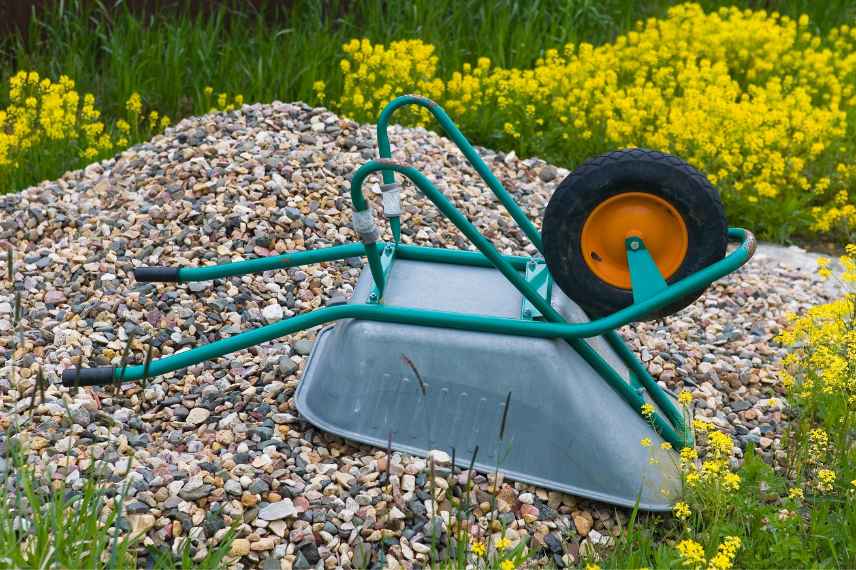
Remember to turn wheelbarrows upside down, especially when storms or rain are forecast
A few additional measures to limit mosquito proliferation
Beyond watering mistakes that many of us make, a few simple actions can help repel unwanted pests or at least limit their spread.
First, you could try repellent plants that deter mosquitoes, such as lemongrass or scented geraniums. These can be grown in the garden or in pots. To learn more, check out our article: 10 Effective Mosquito-Repellent Plants.
Next, consider setting up traps. Devices that use light to attract pests and eliminate them with an electric shock are effective. However, they require a power source and, more importantly, are not selective—unfortunately, other insects may also be affected. There are other outdoor traps, such as bucket-style designs, that capture adult mosquitoes when they attempt to lay eggs. Lured into the container, the females become stuck on adhesive strips and cannot escape. For these to work, they must be placed correctly, and it’s essential to remove any other potential breeding sites first.
At the same time, remember to refresh pet water bowls regularly. Also, keep gutters clean to remove any plant debris that could encourage water stagnation.
Finally, let’s not forget that mosquitoes have natural predators: birds, bats, dragonflies, amphibians… So, encourage their presence by installing nest boxes, feeders, water dishes (emptied regularly to prevent standing water), shelters, and more.
- Subscribe!
- Contents
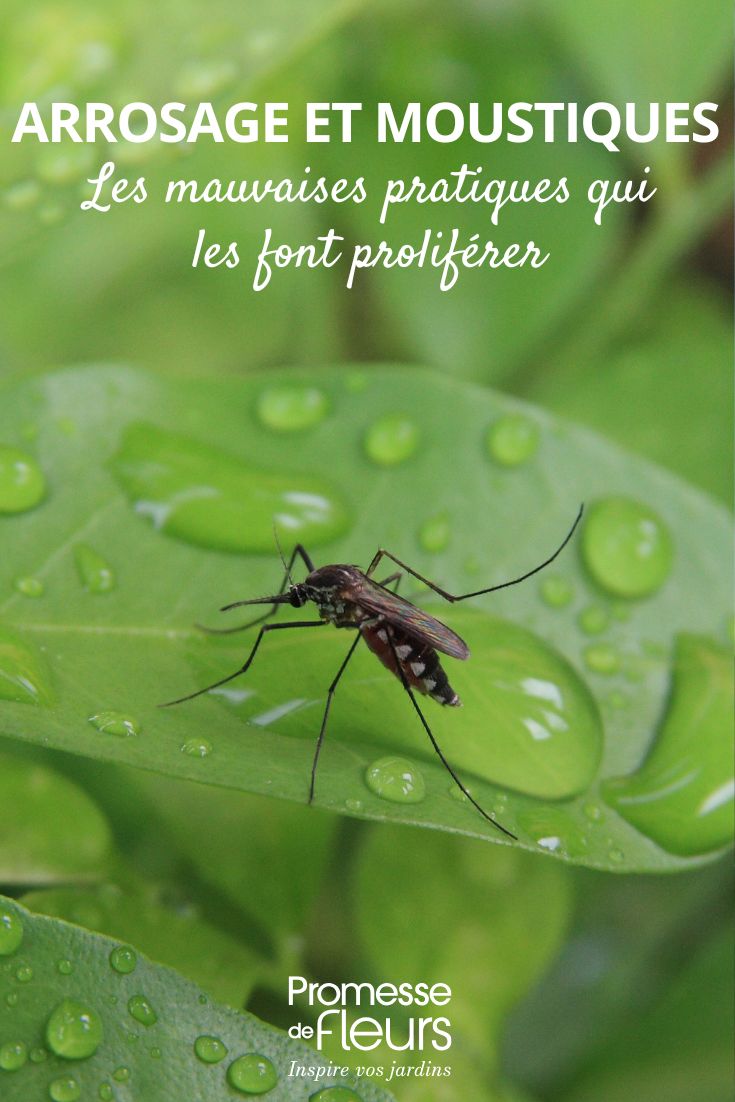































Comments